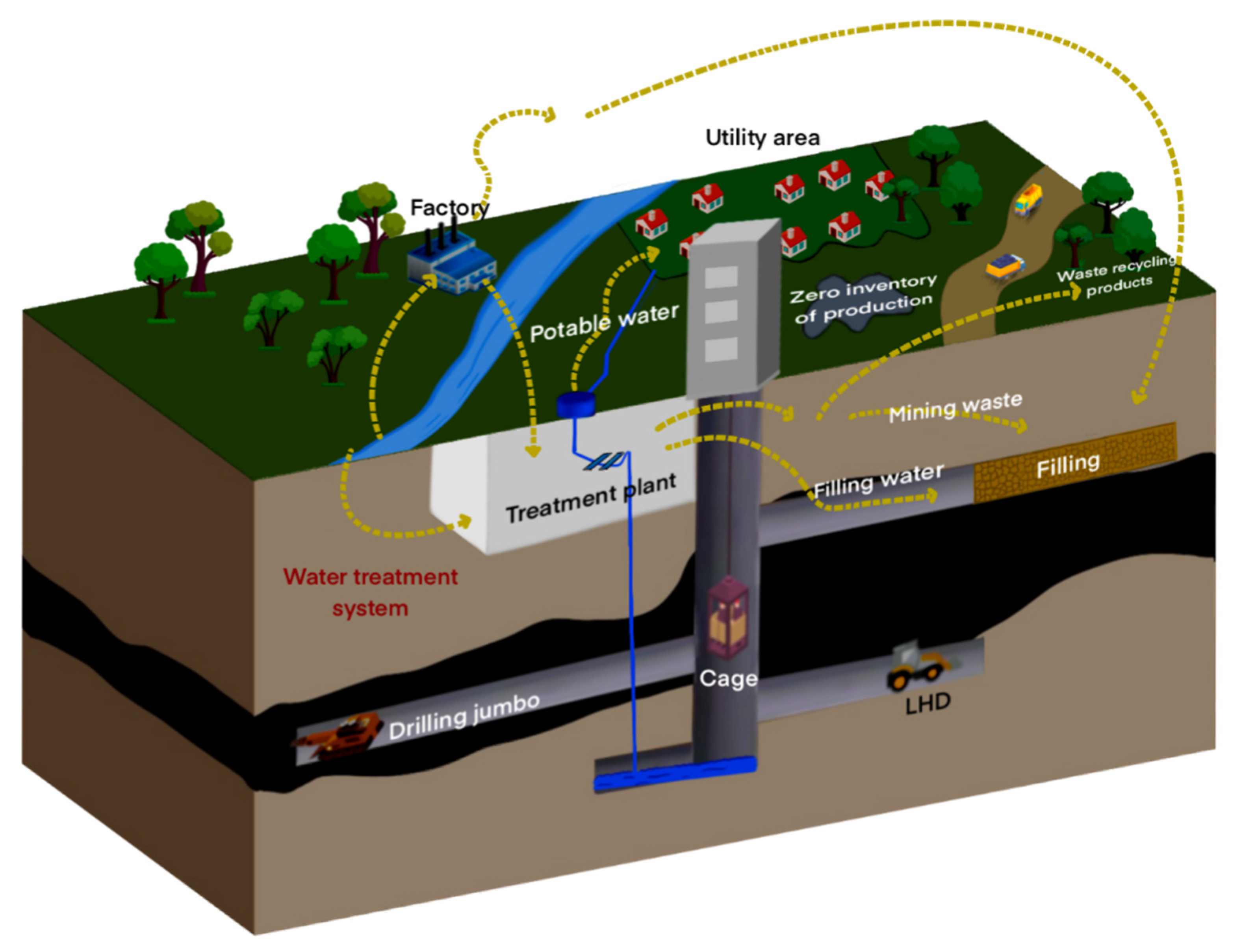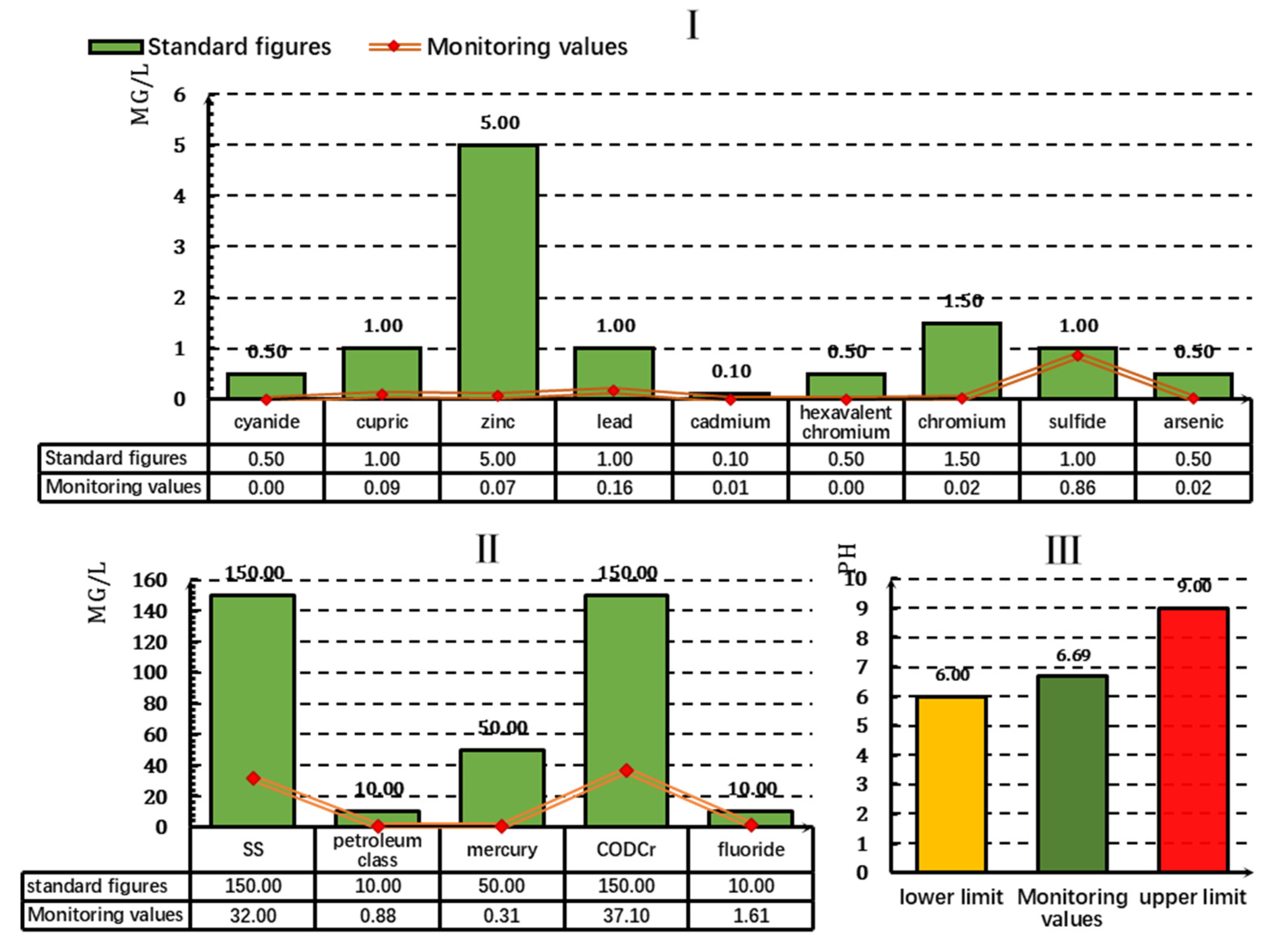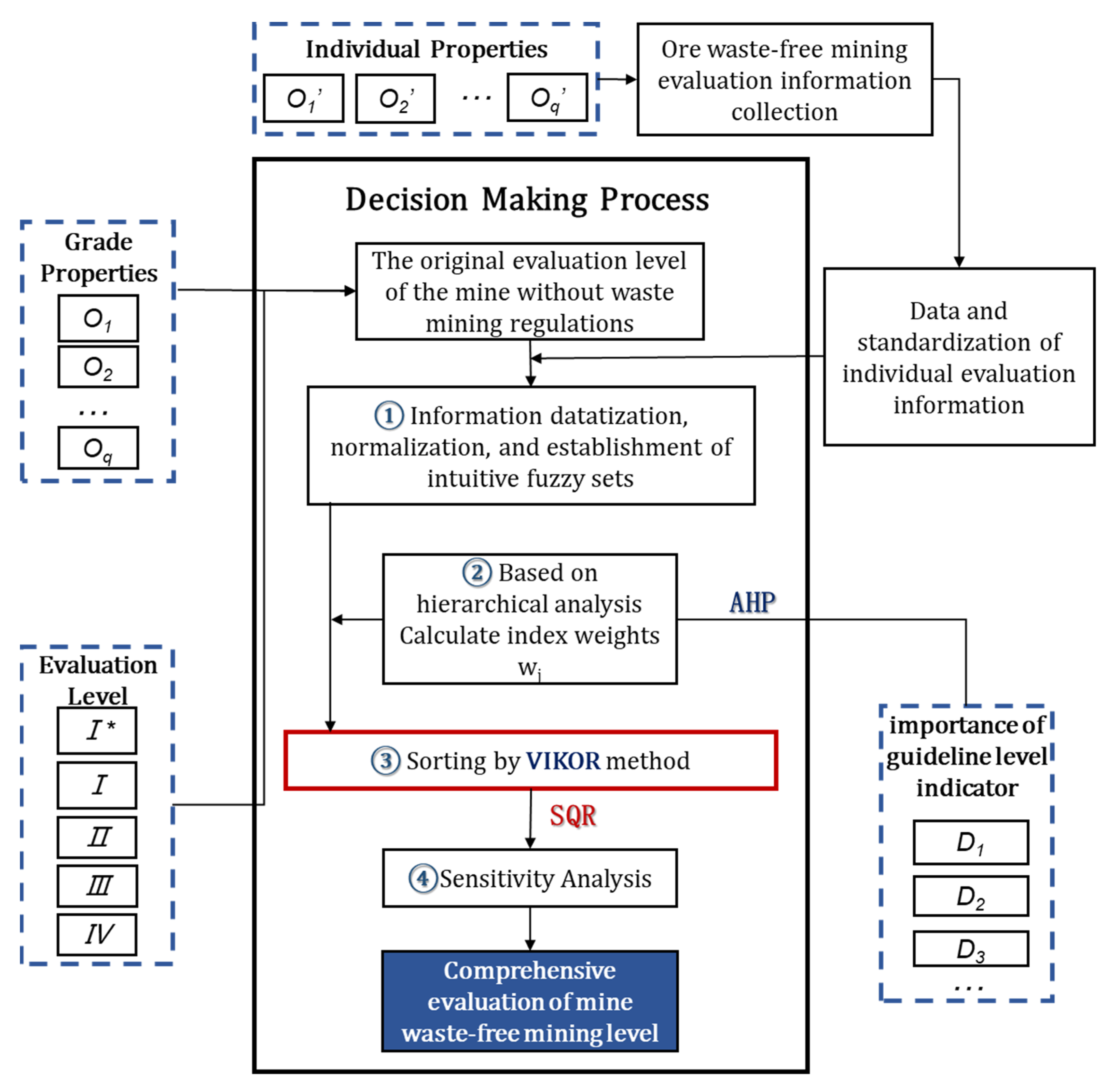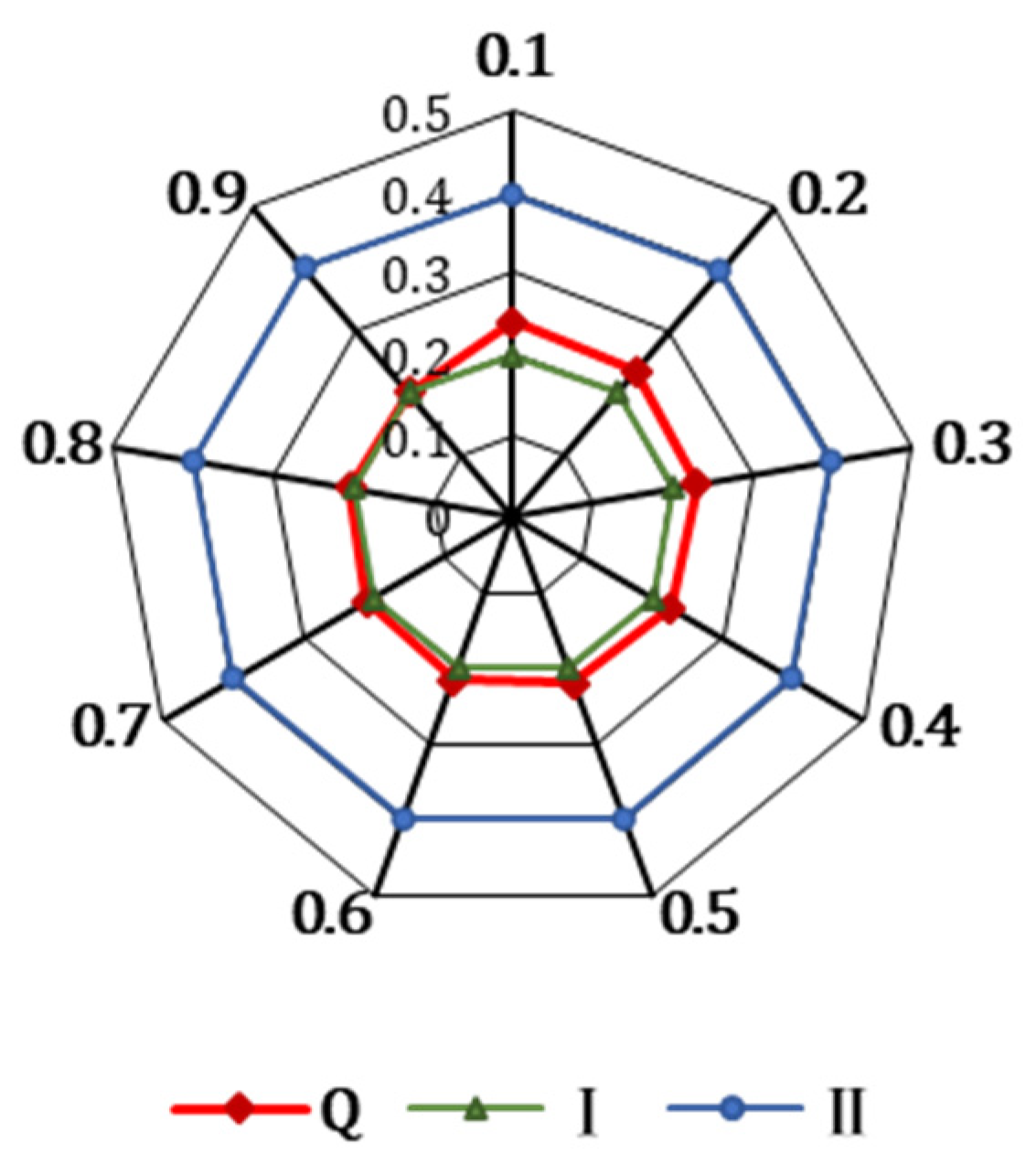Quality Evaluation of Wasteless Mining in Dongguashan Based on Intuitionistic Fuzzy Set and VIKOR
Abstract
:1. Introduction
2. Theory of Wasteless Mining Methods
2.1. Overview of Wasteless Mining
2.2. Planning Principles for Wasteless Mining
- (1)
- Waste reduction. Under the premise of safety and economic rationality, the number of mining activities and the output of waste rock should be reduced in the preliminary design of the mine, and the mining parameters should be optimized to reduce the loss depletion rate and stabilize the ore input grade;
- (2)
- Comprehensive utilization of resources. For poor ore or ore with high mining difficulty, reasonable ore blending is required to improve the utilization rate of mineral resources; the waste rock, tailing sand and wastewater should be comprehensively recovered to realize the waste treatment;
- (3)
- In situ processing and utilization. The waste rock can be treated in the field to avoid waste transportation, and the transportation distance can be reduced as much as possible;
- (4)
- Control of secondary pollution. The useful components in the tailings and wastewater treatment can be recovered; the mineral processing and wastewater treatment-related technologies can be further explored to improve the degree of the resourcefulness of waste materials; the pollution generated by the treatment should be reduced to avoid secondary pollution;
- (5)
- Using advanced equipment and techniques. The advanced mining equipment and techniques should be developed in wasteless mining to achieve the mechanization, automation, and intelligent transformation of mines. Finally, the mining efficiency and mining enterprises’ comprehensive benefits can be greatly improved;
- (6)
- The unity of economic, environmental and social benefits. Wasteless mining can be used to ensure the environmental and social benefits, as well as the economic benefits of the enterprise;
- (7)
- Adaptation to local conditions and circumstances. During the wasteless mining, optimal planning of wasteless mining for the mining enterprise can be obtained by analyzing the mining enterprise’s own situation and the current economic market [13].
2.3. Reference Standard for Wasteless Mining Evaluation
3. Intuitionistic Fuzzy Sets and VIKOR Method Theory
3.1. Definition of Intuitionistic Fuzzy Sets
3.2. Intuitive Fuzzy Set Multi-Attribute Decision Making
3.3. VIKOR Method
4. Case Study
4.1. Overview of the Dongguashan Copper Mine
4.2. Evaluation of Wasteless Mining in Dongguashan Based on Intuitionistic Fuzzy Set and VIKOR
| Class I wasteless mining: | 0.0 ≤ Si ≤ 0.2, 0.000 ≤ Ri ≤ 0.074 and 0.000 ≤ Qi ≤ 0.199 |
| Class II wasteless mining: | 0.2 ≤ Si ≤ 0.4, 0.074 ≤ Ri ≤ 0.149 and 0.199 ≤ Qi ≤ 0.398 |
| Class III wasteless mining: | 0.4 ≤ Si ≤ 0.6, 0.149 ≤ Ri ≤ 0.223 and 0.398 ≤ Qi ≤ 0.598 |
| Class IV wasteless mining: | 0.6 ≤ Si ≤ 1.0, 0.223 ≤ Ri ≤ 0.372 and 0.598 ≤ Qi ≤ 0.996 |
5. Conclusions and Prospects
Author Contributions
Funding
Institutional Review Board Statement
Informed Consent Statement
Data Availability Statement
Conflicts of Interest
References
- Ju, J. Building the support system of green mine construction in China. China Min. Mag. 2020, 29, 3. [Google Scholar]
- Ju, J.; Qiang, H. The trend and direction of green development of the mining industry in China. China Min. Mag. 2017, 26, 7–12. [Google Scholar]
- Zhao, Y.; Zhao, G.-Y.; Pei, D.-F.; Wu, P.; Qiu, J.; Li, Y. Analysis on connotation, characteristics and type of green mining mode for underground metal mines. Chin. J. Nonferrous Met. 2021, 31, 3700–3712. [Google Scholar]
- Wang, H.-R.; Zhang, Y.-K.; Tian, Z.-Y.; Zou, Z.-Q. Exploration and Practice of the Non-waste Mining Method in Mine based on Circular Economy Theory. Met. Mine 2011, 40, 36–40. [Google Scholar]
- Hu, S.-F.; Niu, M.-Y.; Liu, D.-P. Study on comprehensive utilization technology of non-waste mining of mid-and low-grade phosphate rock in Hubei region. IM&P 2018, 47, 3. [Google Scholar]
- Qi, H.-G.; Zhang, N.; Li, J.; Zheng, Z.; Zhu, L.; Guan, Z. Research on scientific mining model of “short-wall filling & long-wall mining” in coal mines. Coal Sci. Technol. 2019, 47, 11. [Google Scholar]
- Xue, X.-L.; Dai, Y.; Fan, Y.-L.; Zhang, X.; Liu, D.-Q.; Zhang, S.-W. Study on the Mode and Technology for Wasteless Synergistic Mining of Hard Rock Uranium Deposits. Met. Mine 2020, 50, 95. [Google Scholar]
- Xu, S.-D.; Li, Y.-H.; Liu, J.-P. Application of wasteless mining in Hongtoushan Copper Mine. Adv. Mater. Res. 2013, 734–747, 722–726. [Google Scholar] [CrossRef]
- Qiao, D.; Wang, X. Modern Mining Concept and Filling Technique. Non-Ferr. Met. Sci. Eng. 2013, 2, 7–14. [Google Scholar]
- Kotarska, I.; Barbara, M.; Pawel, S. Mining waste in the circular economy—Idea versus reality. In E3S Web of Conferences; EDP Sciences: Les Ulis, France, 2018; p. 41. [Google Scholar]
- Peng, H.S. Planning and Evaluation of Mine Wasteless Mining. Ph.D. Thesis, Central South University of Technology, Changsha, China, 2000. [Google Scholar]
- Zhen, H.C. Quantitative Assessment of Wasteless Mining Level of Mines. Met. Mine 2005, 217–218, 223. [Google Scholar]
- Huang, Z.W. The Research for the Theory of Wasteless Mining Appraise. Ph.D. Thesis, Central South University, Changsha, China, 2003. [Google Scholar]
- Huang, Z.W.; Gu, D.S. The Mathematical model of evaluation of non-waste mining. China Min. Mag. 2003, 12, 39–42. [Google Scholar]
- Naseem, S.; Fu, G.-L.; Muhammad, M.; Rehman, M.Z.; Baiget, S.A. Semi-Quantitative Environmental Impact Assessment of Khewra Salt Mine of Pakistan: An Application of Mathematical Approach of Environmental Sustainability. Min. Metall. Explor. 2020, 37, 1185–1196. [Google Scholar] [CrossRef]
- Zhou, Q.H.; Wang, Q. Research on Low Carbon Supplier Selection Based on Intuitionistic Fuzzy Sets and VIKOR. Sci. Technol. Manag. Res. 2017, 37, 5. [Google Scholar]
- Geng, X.L.; Ye, C.M. A Service Supplier Evaluation Approach Based on VIKOR with Vague Set. Ind. Eng. Manag. 2014, 19, 8. [Google Scholar]
- Den, J.; Gu, G.S.; Li, X.B.; Peng, H.S. Sustainable Development Concept-Based New Stage Mining Mode for Underground Mines. Met. Mine 2000, 3, 19–21. [Google Scholar]
- Huang, Z.W.; Zhang, B.X. The research for the wasteless method based on the principle of imitative biology group system. China Min. Mag. 2004, 5, 67–70. [Google Scholar]
- Liu, Z.X.; Han, K.W.; Yang, S.; Liu, Y.X. Fractal evolution mechanism of rock fracture in undersea metal mining. J. Cent. South Univ. 2020, 27, 1320–1333. [Google Scholar] [CrossRef]
- Huang, J.J.; Ni, J.Z.; Song, Y.F.; Wang, Y.J.; Zhu, G. Discussion on the Evaluation Index System for Green Mine Construction. Met. Mine 2009, 39, 147. [Google Scholar]
- Song, X.F.; Wen, B. Research into the quantitative evaluation of the green mine construction. China Min. Mag. 2014, 23, 4. [Google Scholar]
- Li, X.; Yang, J.J.; Yan, H.C. Study on evaluation index system of green mine construction. In IOP Conference Series: Earth and Environmental Science; IOP Publishing: Bristol, UK, 2017; p. 94. [Google Scholar]
- Shang, D.; Yin, G.; Li, X.; Li, Y.; Jiang, C.; Kang, X.; Liu, C.; Zhang, C. Analysis for Green Mine (phosphate) performance of China: An evaluation index system. Resour. Policy 2015, 46, 71–84. [Google Scholar] [CrossRef]
- GB 8978-1996; Integrated Wastewater Discharge Standard. Ministry of Ecology and Environment: Beijing, China, 1996.
- Xia, Q.; Liu, H.P.; Liu, F.; Hao, L.F. Revision Note of National Standards “Environmental Quality Standard for Surface Water (GB3838-88)” for the People’s Republic of China. Res. Environ. Sci. 1988, 1–95. [Google Scholar]
- National Standards “Environmental Quality Standard for Surface Water (GB3838-88)” for the People’s Republic of China. Res. Environ. Sci. 1988, 7, 96–102.
- GB 3838-2002; Environmental Quality Standard for Surface Water. Ministry of Ecology and Environment: Beijing, China, 2002.
- GB/T 14848-2017; Standard for Groundwater Quality. Ministry of Ecology and Environment: Beijing, China, 2017.
- GB 16297-1996; Integrated Emission Standard of Air Pollutants. Ministry of Ecology and Environment: Beijing, China, 1996.
- GB 15618-1995; Environmental Quality Standard for Soils. National Environmental Protection Bureau: Beijing, China; State Bureau of Technical Supervision: Beijing, China, 1995.
- Chen, G.R.; Tian, S.P. The Mixed Multi-attribute Group Decision Making Method Based on Intuitionistic Fuzzy VIKOR. Control. Eng. China 2019, 26, 7. [Google Scholar]
- Qin, Y.; Fu, Y.; Li, W.T. Operational Safety and Reliability Assessment of High-Speed Train With Intuitionistic Fuzzy Set and VIKOR Method. J. Beijing Univ. Technol. 2018, 44, 8. [Google Scholar]
- Zhai, Z.G.; Liu, Y.P.; Wang, X.L. Evaluation criterion and method of green mine. China Coal 2012, 38, 5. [Google Scholar]
- Zhong, C.; Hu, N.L.; Duan, S.F.; Zhang, N.; Xiu, G.; Li, G. Research on Evaluation System of Green Mines in Non-ferrous Metal Industry. Min. Res. Dev. 2019, 39, 6. [Google Scholar]






| Grade | Contamination Level | Utilization Rate of Waste Rock and Tailings |
|---|---|---|
| I | Non-pollution | 80–100% |
| II | Mild pollution | 70–80% |
| III | Moderate pollution | 60–70% |
| IV | Severe pollution | 0–60% |
| Grade | Contamination Level | Percentage of Exceedance/% |
|---|---|---|
| I | Non-pollution | Not exceeded |
| II | Mild pollution | 0–200 |
| III | Moderate pollution | 200–300 |
| IV | Severe pollution | More than 300 |
| Grade | Degree of Impact |
|---|---|
| I | Unaggravated |
| II | Aggravating Grade 1 |
| III | Aggravating Grade 2 |
| IV | Aggravating Grade 3 and above |
| Grade | Contamination Level | Concentrations | |||||
|---|---|---|---|---|---|---|---|
| Dust Fall | Floating Dust | SO2 | NOX | CO | Total Oxidizer | ||
| I | Ideal | ≤8 | ≤0.10 | ≤0.05 | ≤0.02 | ≤2 | ≤0.5 |
| II | Good | ≤12 | ≤0.15 | ≤0.15 | ≤0.05 | ≤4 | ≤0.10 |
| III | Safety | ≤20 | ≤0.25 | ≤0.25 | ≤0.10 | ≤6 | ≤0.20 |
| IV | Pollution | ≤40 | ≤0.50 | ≤0.50 | ≤0.20 | ≤12 | ≤0.40 |
| V | Heavy pollution | >40 | >0.50 | >0.50 | >0.20 | >12 | >0.40 |
| Project | IV Standard Value | Monitoring Values | |||
|---|---|---|---|---|---|
| GB3838-88 | GB3838-2002 | Measurement Point 1 | Measurement Point 2 | Measurement Point 3 | |
| pH | 6.5–8.5 | 6.0–9.0 | 8.08 | 7.71 | 7.7 |
| CODcr | ≤30 | ≤30 | 9.7 | 14.7 | 23.3 |
| SS | 38.5–51.5 | 51.5 | 39.2 | 38.5 | |
| Petroleum | ≤0.5 | ≤0.5 | 1.35 | 1.63 | 1.13 |
| Sulfide | ≤0.5 | ≤0.5 | 0.02 | 0.02 | 0.02 |
| Total Copper | ≤1.0 | ≤1.0 | 0.009 | 0.014 | 0.05 |
| Total Lead | ≤0.05 | ≤0.05 | 0.013 | 0.013 | 0.013 |
| Total Zinc | ≤2.0 | ≤2.0 | 0.007 | 0.021 | 0.022 |
| Total Cadmium | ≤0.005 | ≤0.005 | 0.002 | 0.002 | 0.002 |
| Chromium | ≤0.05 | ≤0.05 | 0.004 | 0.004 | 0.004 |
| Total Mercury | ≤0.001 | ≤0.001 | 0.00004 | 0.00004 | 0.00004 |
| Total Arsenic | ≤0.1 | ≤0.1 | 0.0023 | 0.0053 | 0.0033 |
| Dissolved iron | ≤0.5 | ≤0.3 | 0.429 | 0.235 | 0.826 |
| Exhaust Flow | Monitoring Factors | Monitoring Results | ||||
|---|---|---|---|---|---|---|
| Flow Rate Range | Average Flow Rate | Dust | Concentration Range | Average Concentration | Emission Rate | |
| (N·m3/h) | (N·m3/h) | /(mg/m3) | /(mg/m3) | /(kg/h) | ||
| 1726–2121 | 1972 | 47–83 | 64 | 0.126 | ||
| Standard limit values | 120 | 34 | ||||
| Monitoring Sites | pH | Cu | Pb | Zn | Cd | As | |
|---|---|---|---|---|---|---|---|
| 1 | Surface layer 0–20 cm | 8.23 | 88.5 | 74.4 | 117 | 0.280 | 4.10 |
| Middle layer 20–60 cm | 8.64 | 45.8 | 57.9 | 69.1 | 0.196 | 3.85 | |
| Deep layer 60–100 cm | 8.50 | 50.1 | 49.9 | 62.6 | 0.112 | 3.39 | |
| 2 | Surface layer 0–20 cm | 7.96 | 92.1 | 161 | 203 | 0.293 | 12.9 |
| Middle layer 20–60 cm | 7.79 | 81.5 | 133 | 187 | 0.213 | 11.4 | |
| Deep layer 60–100 cm | 7.68 | 69.7 | 120 | 141 | 0.158 | 8.85 | |
| IV standard value in GB15618-95 | >6.5 | ≤400 | ≤500 | ≤500 | ≤1.0 | ≤30 | |
| Evaluation Indicators | Waste Rock Utilization Rate | Tailings Utilization Rate | Wastewater Pollution | Exhaust Emissions | Soil Environment | Resources Recovery Rate |
|---|---|---|---|---|---|---|
| Mine situation | 93.52% | 84.36% | No wastewater | No exhaust gas | Great quality | 73.10% |
| Grade | Waste Rock and Tailing Sand Utilization/% | Wastewater Exceeds the Standard/% | Exhaust and Soil Quality | Resource Recovery/% | Affiliation | Non-Affiliation |
|---|---|---|---|---|---|---|
| I* | 100 | No wastewater | No exhaust gas | 100 | 1 | 0 |
| I | 80 | 0 | Unaggravated | 80 | 0.8 | 0.2 |
| II | 70 | 200 | Aggravated Grade 1 | 70 | 0.6 | 0.4 |
| III | 60 | 300 | Aggravated Grade 2 | 60 | 0.4 | 0.6 |
| IV | 0 | >300 | Aggravated Grade 3 and above | 0 | 0 | 1 |
| Waste Rock Utilization | Tailings Utilization | Wastewater Exceeds the Standard | Exhaust Gas | Quality of Soil | Recovery of Resource | |
|---|---|---|---|---|---|---|
| Affiliation | 0.9352 | 0.8436 | 0.8000 | 0.8000 | 0.8000 | 0.7310 |
| Non-affiliation | 0.0648 | 0.1564 | 0.1500 | 0.1500 | 0.1500 | 0.2190 |
| O j | O 1 | O 2 | O 3 | O 4 | O 5 | O 6 | wj |
|---|---|---|---|---|---|---|---|
| Waste Rock Utilization | Tailings Utilization | Wastewater Exceeds the Standard | Exhaust Gas | Quality of Soil | Recovery of Resource | ||
| O 1 | 1 | 1 | 1/3 | 1/3 | 1/2 | 1/6 | 0.062 |
| O 2 | 1 | 1 | 1/3 | 1/3 | 1/2 | 1/6 | 0.062 |
| O 3 | 3 | 3 | 1 | 1 | 2 | 1/2 | 0.195 |
| O 4 | 3 | 3 | 1 | 1 | 2 | 1/2 | 0.195 |
| O 5 | 2 | 2 | 1/2 | 1/2 | 1 | 1/3 | 0.114 |
| O 6 | 6 | 6 | 2 | 2 | 3 | 1 | 0.372 |
| λmax = 6.013; CI = 0.0026; CR = 0.00206 < 0.01; consistency check passed | |||||||
| S | R | Q | |
|---|---|---|---|
| I* | 0 | 0 | 0 |
| I | 0.2 | 0.0744 | 0.1992 |
| II | 0.4 | 0.1488 | 0.3984 |
| III | 0.6 | 0.2232 | 0.5976 |
| IV | 1 | 0.372 | 0.996 |
| Dongguashan Copper Mine | 0.194348715 | 0.091613261 | 0.219325372 |
| Affiliation Level | I | II | II |
| ν | 0.1 | 0.2 | 0.3 | 0.4 | 0.5 | 0.6 | 0.7 | 0.8 | 0.9 |
| I | 0.1986 | 0.1987 | 0.1989 | 0.1990 | 0.1992 | 0.1994 | 0.1995 | 0.1997 | 0.1998 |
| II | 0.3971 | 0.3974 | 0.3978 | 0.3981 | 0.3984 | 0.3987 | 0.3990 | 0.3994 | 0.3997 |
| Q | 0.2393 | 0.2343 | 0.2293 | 0.2243 | 0.2193 | 0.2143 | 0.2093 | 0.2043 | 0.1993 |
| Positive Distance | Negative Distance | Relative Proximity | Affiliation Level | |
|---|---|---|---|---|
| I* | 0.0000 | 0.5244 | 1.0000 | I |
| I | 0.1049 | 0.4195 | 0.8000 | I |
| II | 0.2098 | 0.3146 | 0.6000 | II |
| III | 0.3146 | 0.2098 | 0.4000 | III |
| IV | 0.5244 | 0.0000 | 0.0000 | IV |
| Dongguashan Copper Mine | 0.1286 | 0.4109 | 0.7616 | II |
Publisher’s Note: MDPI stays neutral with regard to jurisdictional claims in published maps and institutional affiliations. |
© 2022 by the authors. Licensee MDPI, Basel, Switzerland. This article is an open access article distributed under the terms and conditions of the Creative Commons Attribution (CC BY) license (https://creativecommons.org/licenses/by/4.0/).
Share and Cite
Yang, S.; Li, K.; Wu, S.; Xu, Z.; Liu, T. Quality Evaluation of Wasteless Mining in Dongguashan Based on Intuitionistic Fuzzy Set and VIKOR. Appl. Sci. 2022, 12, 8249. https://doi.org/10.3390/app12168249
Yang S, Li K, Wu S, Xu Z, Liu T. Quality Evaluation of Wasteless Mining in Dongguashan Based on Intuitionistic Fuzzy Set and VIKOR. Applied Sciences. 2022; 12(16):8249. https://doi.org/10.3390/app12168249
Chicago/Turabian StyleYang, Shan, Ke Li, Shuliang Wu, Zitong Xu, and Taoying Liu. 2022. "Quality Evaluation of Wasteless Mining in Dongguashan Based on Intuitionistic Fuzzy Set and VIKOR" Applied Sciences 12, no. 16: 8249. https://doi.org/10.3390/app12168249






